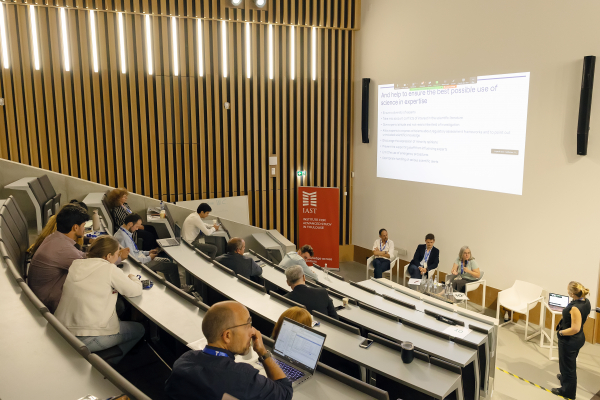Biodiversity loss looms large over our world. By now, 50% of the natural world is under threat as a result of human disturbance. The science is clear: Action in both the private and the public sphere is needed, and it is needed now. However, as usual, while the science might be clear, it is much more challenging to translate scientific findings into policy or investment strategies. At the “Investing for Biodiversity Workshop” organised at Toulouse School of Economics last September, a panel of experts from Finance, Law, and Policy convened to discuss the issues faced by modern decision makers when it comes to curbing biodiversity loss.
 Marion Desquilbet, researcher in Economics, (TSE, INRAE) spoke about the credibility in scientific expertise. She has previously worked on a report offering recommendations to reinforce the reputation of Anses, a French agency that both provides independent scientific expertise for policy advice, yet also actively partakes in regulation. This double function, coupled with some questionable expertise implementations, funding decisions and withholding of information, has led to agency’s reputation plummeting. Furthermore, the report reveals that public belief in the agency’s work is harmed by the simple fact that biodiversity decline is not stopping. That begs the main question the economist posed in her talk: “How can we take science into account effectively when it comes to regulation?” In other words, how can we restore the credibility of scientific reports and actually translate knowledge into action? This is a particularly challenging task in fields where scientific facts might run counter to economic interest or political power struggles – Marion Desquilbet’s area of specialty happens to be pesticides. She offers clear suggestions on improvement: independent scientific assessment should be better separated from risk assessment within a constrained regulatory framework. Criticism of current systems must not be suppressed, and safety of the critics must be guaranteed. According to the researcher, France is in better shape than most countries – amongst others, previous public health crises helped improve how scientific advisory operates. However, credibility is more easily lost than gained, so wariness is imperative going forward.
Marion Desquilbet, researcher in Economics, (TSE, INRAE) spoke about the credibility in scientific expertise. She has previously worked on a report offering recommendations to reinforce the reputation of Anses, a French agency that both provides independent scientific expertise for policy advice, yet also actively partakes in regulation. This double function, coupled with some questionable expertise implementations, funding decisions and withholding of information, has led to agency’s reputation plummeting. Furthermore, the report reveals that public belief in the agency’s work is harmed by the simple fact that biodiversity decline is not stopping. That begs the main question the economist posed in her talk: “How can we take science into account effectively when it comes to regulation?” In other words, how can we restore the credibility of scientific reports and actually translate knowledge into action? This is a particularly challenging task in fields where scientific facts might run counter to economic interest or political power struggles – Marion Desquilbet’s area of specialty happens to be pesticides. She offers clear suggestions on improvement: independent scientific assessment should be better separated from risk assessment within a constrained regulatory framework. Criticism of current systems must not be suppressed, and safety of the critics must be guaranteed. According to the researcher, France is in better shape than most countries – amongst others, previous public health crises helped improve how scientific advisory operates. However, credibility is more easily lost than gained, so wariness is imperative going forward.
 Julien Bétaille (UT Capitole) gave an overview about current trends in biodiversity law and litigation. Biodiversity laws are becoming more and more abundant – including National Park designations or land use policies like the European Habitats Directive. However, the strength of those laws differs: The Natura2000 framework has much less legal traction than designating a new National Park, the jurist argues. And while such laws might have prevented species extinctions, the abundance of many species has been severely limited in recent years. Therefore, litigation conducted by environmental NGOs becomes more and more important. As Julien Bétaille puts it: “When an NGO uses litigation, it defends the interest of nature in front of a court.” In that vein, the rights of wolves, ibexes, bears and dolphins are all being fought for by NGOs in France. Crucially, it depends on the legal tradition in each country how strongly of an influence these litigations can have. While French tradition allows this, other countries have a more individualistic view: As long as a civilian is not affected by an extinction, they might have no right to go to court. However overall, biodiversity law seems to be developing positively. The recent Kunming-Montreal biodiversity agreement is a wonderful example of this trend, as is the current push for more ecological restoration in the EU. However, short election cycles and politically vested interests can distort the long-term project that is biodiversity conservation.
Julien Bétaille (UT Capitole) gave an overview about current trends in biodiversity law and litigation. Biodiversity laws are becoming more and more abundant – including National Park designations or land use policies like the European Habitats Directive. However, the strength of those laws differs: The Natura2000 framework has much less legal traction than designating a new National Park, the jurist argues. And while such laws might have prevented species extinctions, the abundance of many species has been severely limited in recent years. Therefore, litigation conducted by environmental NGOs becomes more and more important. As Julien Bétaille puts it: “When an NGO uses litigation, it defends the interest of nature in front of a court.” In that vein, the rights of wolves, ibexes, bears and dolphins are all being fought for by NGOs in France. Crucially, it depends on the legal tradition in each country how strongly of an influence these litigations can have. While French tradition allows this, other countries have a more individualistic view: As long as a civilian is not affected by an extinction, they might have no right to go to court. However overall, biodiversity law seems to be developing positively. The recent Kunming-Montreal biodiversity agreement is a wonderful example of this trend, as is the current push for more ecological restoration in the EU. However, short election cycles and politically vested interests can distort the long-term project that is biodiversity conservation.
In a brutally honest assessment of the reality of biodiversity finance, Guillaume Lasserre (LBP AM) gave an insight into the current workings of asset management. “When we think a bout managing biodiversity, is it about managing externalities? Clearly not only.” Instead, this field is still so new and emerging, yet so complex that there are no clear directions on how to direct cash flows. At this point, the banker admitted, there is no framework for managing biodiversity investments. Data on the biodiversity performance, meaning to lower the pressure on biodiversity, of firms is scarce, and it is almost impossible to compare two firms with the current available methods. Furthermore, biodiversity decline adds another layer of complexity to already difficult investment decisions. A traditional example of this problem is this: Imagine an investment in lithium mining. The project supposedly is good for energetic transition, but could have many negative impacts on biodiversity through pollution and deforestation. A too simplistic approach of sustainable finance, according to Guillaume Lasserre, would not invest in this project. Add biodiversity to the mix of absolute limits of investment, and there are few investment opportunities left. Ultimately, asset management with biodiversity conservation in mind is new and uncharted terrain, and Guillaume Lasserre is only sure about one thing: We need optimism to prevail in these times of uncertainty.
bout managing biodiversity, is it about managing externalities? Clearly not only.” Instead, this field is still so new and emerging, yet so complex that there are no clear directions on how to direct cash flows. At this point, the banker admitted, there is no framework for managing biodiversity investments. Data on the biodiversity performance, meaning to lower the pressure on biodiversity, of firms is scarce, and it is almost impossible to compare two firms with the current available methods. Furthermore, biodiversity decline adds another layer of complexity to already difficult investment decisions. A traditional example of this problem is this: Imagine an investment in lithium mining. The project supposedly is good for energetic transition, but could have many negative impacts on biodiversity through pollution and deforestation. A too simplistic approach of sustainable finance, according to Guillaume Lasserre, would not invest in this project. Add biodiversity to the mix of absolute limits of investment, and there are few investment opportunities left. Ultimately, asset management with biodiversity conservation in mind is new and uncharted terrain, and Guillaume Lasserre is only sure about one thing: We need optimism to prevail in these times of uncertainty.
This panel discussion at the “Investing for Biodiversity Workshop” demonstrated both the status quo as well as the challenges that lie ahead. It seems like there is incremental positive change when it comes to curbing biodiversity loss, but the institutional surroundings and the (lack of) translation of scientific knowledge into action or policy have hindered substantial leaps for now. Each of the panellists stressed the importance of interdisciplinary communication, as well as communication between science and practice. More communication yields more credibility to scientists; it makes the impact of environmental laws clearer to the public, and it gives asset managers better directions where to direct their investments. Ultimately, that is what we need to counteract the looming threat that is biodiversity loss.
Find out more on the Investing for Biodiversity Workshop's webpage
Summary published in TSE Reflect, October 2023
Photo © Studio tChiz
